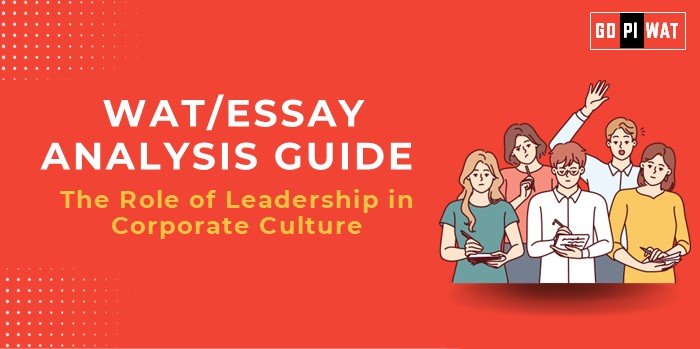📋 The Role of Leadership in Corporate Culture
🌐 Group Discussion Analysis Guide
Introduction
Opening Context: Leadership significantly influences corporate culture, shaping the environment in which employees collaborate and innovate. In today’s competitive corporate world, fostering a positive culture is essential for achieving sustainable success.
Topic Background: From transformational leadership theories to modern-day management practices, the focus has shifted to creating environments where employees thrive. The link between strong leadership and robust corporate culture has become a cornerstone of corporate success stories.
📊 Quick Facts and Key Statistics
- 📈 Employee Engagement Impact: Companies with strong leadership see 23% higher employee engagement (Gallup, 2023).
- 🚀 Productivity Boost: Positive workplace cultures lead to 12% higher productivity (University of Warwick, 2022).
- 🔄 Turnover Reduction: Poor leadership accounts for 50% of employee turnover (SHRM, 2023).
- 💰 Financial Returns: Organizations with ethical leadership report 20% higher financial performance (Harvard Business Review, 2022).
🤝 Stakeholders and Their Roles
- Executives: Set the tone for corporate values, decision-making, and strategic goals.
- Managers: Serve as the bridge between executives and employees, fostering day-to-day culture.
- Employees: Contribute through behavior aligned with cultural values.
- HR Teams: Design policies to reinforce cultural objectives and leadership training.
- Shareholders: Demand accountability for ethical leadership practices.
🏆 Achievements and Challenges
Achievements:
- ✅ Improved Retention: Organizations with supportive leadership have 50% lower turnover rates.
- ✅ Diversity and Inclusion: Companies with inclusive cultures are 1.7 times more likely to be innovation leaders.
- ✅ Innovation Growth: Transformational leadership increases innovation by 30% (McKinsey, 2023).
- ✅ Resilience During Crises: Effective leaders maintain corporate stability during economic downturns.
Challenges:
- ❌ Leadership Gaps: Only 28% of executives believe their leadership pipeline is robust (Deloitte, 2023).
- ❌ Toxic Environments: Poor leadership fosters negative cultures, affecting employee well-being.
- ❌ Global Comparisons: Nordic countries lead with high trust and collaboration cultures, contrasting challenges in regions with hierarchical systems.
📚 Structured Arguments for Discussion
- Supporting Stance: “Effective leadership fosters alignment with corporate goals and builds resilient organizations.”
- Opposing Stance: “Leadership alone cannot shape culture; systemic barriers and market forces play a bigger role.”
- Balanced Perspective: “While leadership is critical, fostering a positive culture also requires robust systems and shared accountability.”
✨ Effective Discussion Approaches
- Opening Approaches:
- Start with compelling data, such as “Organizations with ethical leadership see 20% higher profits.”
- Share examples of renowned leaders like Satya Nadella transforming Microsoft’s culture.
- Counter-Argument Handling:
- Acknowledge organizational challenges while emphasizing leadership’s potential to overcome barriers with data-backed solutions.
🔍 Strategic Analysis of Strengths and Weaknesses
- Strengths: Inspires collaboration, builds trust, improves productivity.
- Weaknesses: Leadership gaps, resistance to cultural shifts.
- Opportunities: Leverage digital tools for leadership training, focus on diversity.
- Threats: Resistance to change, external market pressures.
✍️ WAT/Essay Analysis Guide
Understanding the Importance
Strong leadership shapes corporate values and policies, directly influencing employee engagement and organizational success. For B-school students, this topic highlights the interplay between management strategies and cultural outcomes.
📑 Structuring the Essay
- Introduction: Discuss leadership’s role in shaping corporate culture.
- Achievements: Highlight transformations in companies like Microsoft under Satya Nadella.
- Challenges: Explore leadership gaps and resistance to cultural change.
- Future Outlook: Predict trends like increased investment in leadership development programs.
📘 Sample Short Essays
- Balanced Perspective: “Leadership is the foundation of corporate culture, but shared responsibility across all levels ensures its success.”
- Solution-Oriented: “By embedding leadership training into corporate strategies, organizations can foster inclusive and innovative cultures.”
- Global Comparison: “Nordic countries demonstrate that trust-based leadership yields high engagement, offering lessons for global corporations.”


